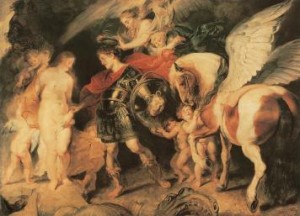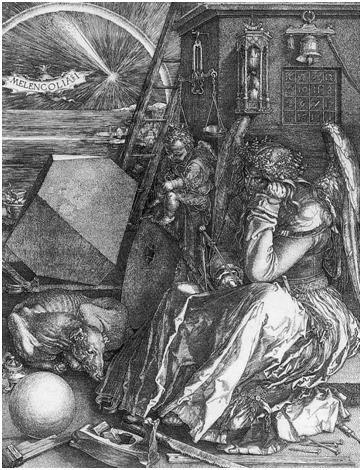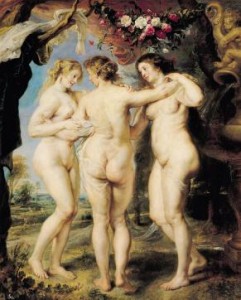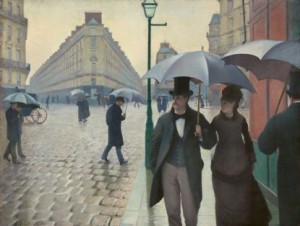You know what one of my favourite movies of all time is? Closer. It’s dark, it’s dirty, it’s intimate, it’s lonely, it’s sad, it’s beautiful, it’s true. “Anna’s” photography exhibit is one I would have visited again and again – you know, if it had been real – especially the image of “Alice”. What other artist makes me feel all of the same emotions? The Impressionist/Realist, Gustave Caillebotte.
Caillebotte’s On the Pont de l’Europe (below), to me anyway, represents a man that has lost something near to him, whether he threw it away or it crumbled into a pile of rubble, the point is that he stands alone on this bridge viewing the Saint-Lazare train station in the cold while others pass him by. When else does one notice the rivets and girders of a bridge than when they’ve got nothing left to see but the smallest things in front of them? I guess that’s what “missing the forest for the trees” hints towards, but sometimes you need to start with the smallest details and work your way out – out of your head, out of the forest, just out.
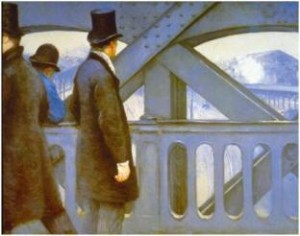
Gustave Caillebotte, On the Pont de l’Europe, 1876–1877. Oil on canvas, 105.7 x 130.8 cm. Kimbell Art Museum, Fort Worth.
And this woman? She’s had a long day at a dead-end job she despises; she comes home and just wants to enjoy being nude in her own space, all the while wondering if her partner is having an affair with their secretary.

Gustave caillebotte, Nude on a Couch, c. 1880. Oil on canvas, 129.54 x 195.58 cm. The Minneapolis Institute of Arts, Minneapolis.
Haven’t we all been here? Maybe not staring at the Saint-Lazare or wondering about our significant others having affairs, but alone in the sense of lonely not just by one’s self. Haven’t we all watched raindrops trickle down a window sill or stared idly at a wall or telephone waiting for one of them to do something? Perhaps we’ve channelled Bridget Jones, drank a half a bottle of wine, and sang loudly to ourselves? I’m not saying I’ve done one or all of these things, but you can’t deny you’ve been there.
Visit the Schirn Kunsthalle Frankfurt to see Caillebotte’s realistic, beautiful, and sometimes sad images from 18 October through 20 January 2013 and realise everyone has days like these. If you’d rather focus on the happier and brighter side of life though, check out this airy and colourful ebook on Impressionism.
-Le Lorrain Andrews
When I open any magazine these days, I look at the photos of waif-like women with perfect skin, hair and teeth, without a jot of cellulite to be seen, and it’s what I expect to see. I admit it! The world of mass media has done its work very well indeed. There is perhaps a handful of women who may be naturally blessed with the genetic make-up to look as flawless as those pictured on billboards without the help of Photoshop. And that’s just it; technology such as Photoshop gives me expectations. If I were to see an ad with the models remaining unaltered, I would be surprised. It’s human nature. To want to look better than we actually do, to make something or someone seem perfect and – with the right product or right clothing – to attract others to the same level of perfection. And then it struck me, this is not a new concept. When I look back at artists from the Renaissance and Baroque period, they do exactly the same thing. (With paintbrush and easel instead of computer and mouse.)

Peter Paul Rubens, Portrait of Susanna Lunden (?) (‘Le Chapeau de Paille’), probably 1622-1625. Oil on wood, 79 x 54.6 cm. The National Gallery, London.
Take a look at some of Peter Paul Rubens’ work. Although the curvier female form was highly admired and painted as it was – childbearing hips and all – Rubens still goes on to use the power invested in him as an artist to present the world with an interpretation of the model and the setting, rather than the real thing (or so I presume, having not been present at the actual time of painting.) In the painting of Susanna Lunden, thought to be a marriage portrait, Rubens’ use of clear and stormy skies to create light and shadow is a way to illuminate the face and much of the upper torso. In other words, she is glowing! Now, if that isn’t a tactic to make someone look more presentable, I don’t know what is!
During this thought process, my brain suddenly went into overdrive, and I began seeing links with modern culture everywhere in Rubens’ paintings. One notable comparison that my oh-so-logical self came up with is the popular past-time of photobombing. You know, you take a picture and when you look back at it, you notice that there’s an unusual face or activity happening in the background? Well, I don’t know about you, but I see a big photobomb in Rubens’ Perseus and Andromeda. My suspicions that Rubens had a sense of humour in his painting were confirmed by this painting. At first glance it looks like a romantic, serious painting. Okay, now look at the shield Perseus is carrying. Look at the expression on Medusa’s face! You heard it here first, Rubens was a photobomb master! (Or should that be paintingbomb?)
If you happen to be in Germany before the end of February and would like to check out more of Rubens’ works, or simply make up your own mind whether he was a paintingbomb genius, head over to the Von der Heydt-Museum Wuppertal. The Rubens exhibition will be held between the 16th October 2012 and the 28th February2013. Alternatively, if going to Germany just isn’t possible right now, check out our book on Rubens written by Victoria Charles.
-Fiona Torsch
I have long considered the artist and the mathematician to be incompatible specimens; geeks and creatives; oil and water. But artists such as Dürer, accomplished in both art and mathematics, certainly make a good case against my point of view.
German Renaissance printmaker Albrecht Dürer made significant contributions to mathematics in literature, publishing works about the principles of mathematics, perspective and ideal proportions. He succeeded at a time when other great thinkers, including polymaths Leonardo da Vinci and Piero della Francesca were thinking in new ways, combining art with mathematics as a way of expressing an ‘ultimate truth’. Nothing conveys Dürer’s capacity for combining the two like his famous engraving Melancholia I (1514):
Scholars have spent centuries analysing the truncated ‘rhombohedron’ (a kind of leaning cube shape) on the left of the image, as the exact geometry of the solid depicted is a subject of some academic debate (all of which involve ratio and angle calculations – not the typical ponderings of an arty type). ‘Dürer’s Solid’, as it is now known, is now part of a larger mathematical theory called the ‘Dürer Graph’ – his mathematical influence remains rife today.
Whatever inspired the creation this scientific art (or artistic science)? It seems the general feeling amongst the artist/mathematician hybrids is that mathematics makes art more beautiful. The ‘Golden Ratio’ for example, applied by the Ancient Egyptians for the building of the pyramids, was regarded as being ‘aesthetically pleasing’.
Does mathematics really enhance art? The jury is still out.
Get to know Dürer and a wealth of other European artists in Dürer and Beyond: Central European Drawings 1400-1700 at The Metropolitan Museum of Art, exhibiting until the 3rd September 2012. Alternatively, treat yourself to Dürer’s most influential works with this beautifully illustrated high-quality art book.
You can blame it on my being an emotional woman if you’d like, I take full responsibility for that, but when I discovered the Wallraf-Richardtz-Museum’s intention to reunite some of the pieces from the 1912 Sonderbund Exhibition of Post-Impressionism through German Expressionism, featuring Van Gogh, Cézanne, Gauguin, Munch, Picasso, Macke, Nolde, Schiele, Signac, etc., I got a bit teary-eyed.
Pieces that have been separated (and sometimes out of view) will be reunited in Cologne until year’s end. It’s reminiscent of one’s days in University and coming back so many years later (clearly not 100) to see how much you’ve changed – or in the case of these paintings and sculptures, hopefully not changed – over time. Maybe one of the girls in the paintings featured below is still alive and will turn up!
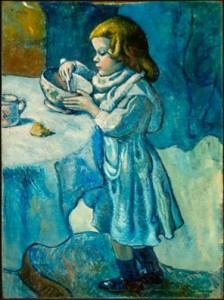
Pablo Picasso, Le Gourmet (The Greedy Child), 1901. Oil on canvas, 92.8 x 68.3 cm. Chester Dale Collection, National Gallery of Art, Washington, D.C.

Ernst Ludwig Kirchner, Fränzi in front of a Carved Chair, 1910. Oil on canvas, 71 x 49.5 cm. Museo Thyssen-Bornemisza, Madrid.
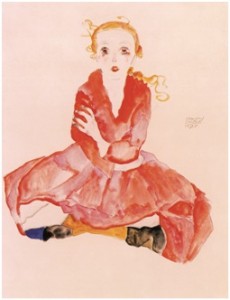
Egon Schiele, Seated Girl Facing Front, 1911. Watercolour and pencil, 46.5 x 31.8 cm. Bayerische Staatsgemäldesammlung, Munich.
There is a fear in the back of my mind, however, that in reuniting these pieces in the same city 100 years later, in a year that’s predicted to end the world, that a vortex will open up and visitors will end up in some alternate universe. Were that universe one with Schiele and friends hanging out enjoying a few glasses of absinthe, I might be keen to jump through and not look back. Sadly, I’m willing to place bets that the other side of that vortex is one of zombies without ears, boundless womanising, and crippling bouts of manic-depression – maybe not so much unlike society today. Would you jump through the vortex unknowing what you’d find?
Nevertheless, I say take the chance and do yourself a favour; book a ticket to Cologne immediately to see 1912-Mission Moderne, as this opportunity to see over 100 pieces of the wonder that was Sonderbund in one place will not come again in our lifetime. Whether you can or cannot make it, purchase these beautiful representations of the pieces on display and more in ebook form: Cézanne, Gauguin, Kirchner, Picasso, Schiele, and Van Gogh.
-Le Lorrain Andrews
Underdogs have taken note and reclaimed terms that were once hurtful or derisory: ‘queer’ has become a positive label for the LGBT community, ‘nerd’ and ‘geek’ are no longer insults but badges of honour (thanks in part to the Gleeks), ‘slut walk’ participants have tried to de-stigmatise the word, and the Tea Party movement’s ‘tea-baggers’…well, that’s a bad example. But this ‘current’ propensity for linguistic reappropriation is not such a modern phenomenon…
The Impressionists came to be known as such after a 10-year battle for recognition. In 19th-century France, artistic esteem could only be attained by recognition by the Academy of Fine Arts and the displaying of their artwork in the Salons, or yearly exhibitions in Paris. This new art movement was too mind-blowing for those stuffy old codgers – Manet’s Luncheon on the Grass didn’t make the grade because of the daring inclusion of a stark-naked lady frolicking at a picnic. I can’t imagine what they would make of Prince Harry’s trip to Las Vegas…
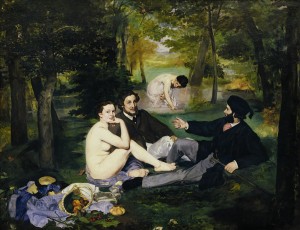
Reconstruction of Prince Harry’s trip to Vegas… Edouard Manet, Luncheon on the Grass, 1863. Oil on canvas, 208 x 264.5 cm. Musée d’Orsay, Paris.
A brief glimmer of hope came in 1863 when Napoleon III, shocked by the quality artwork that was being sidelined, opened an exhibition alongside the official Salon, an Exhibition for Rejects. This group of artists received more visitors than the official Salon, but most came along for a good chuckle at these deluded ‘artists’ and their strange paintings. Requests for another exhibition were denied, until in 1874 they decided to take matters into their own hands…
Thirty artists including Monet, Renoir, Pissarro, Sisley, Cézanne, Degas and Morisot participated in a private exhibition, which was still too zany for many. Louis Leroy wrote a sarcastic, satirical review, coining the term ‘Impressionists’ as a play on words of the title of Monet’s painting Impression, Sunrise. The term caught on, and what was meant to be a moniker of derision became a badge of honour for the group. And Leroy must have been laughing on the other side of his face when Impressionism spread beyond France, paving the way for Modern art, and even becoming the long-lasting legacy of 19th-century French art.
So take a leaf out of the Impressionists’ book and wear those insults with pride. My suggestions for some topically beleaguered individuals include: Prince Harry – ‘The Naked Prince’, Todd Akin – ‘The Legitimator’, and I’m sure Julian Assange could put a positive spin on ‘coward’, ‘tool’ or ‘cyber terrorist’.
Sweden’s Nationalmuseum has an exhibit dedicated to 19th-century France and the beginning of the Modern era, until 3 February 2013. If you would like to read more about the peppy Impressionists, try this impressive art book or compact gift version, written by Nathalia Brodskaya.
What do you think of when someone mentions the Middle Ages? I’d say caves, toga-like clothing, candles, definitely a lot of candles, witches, the burning of said witches, and ceaseless devotion to God. Often, when the internet in my apartment isn’t working, I tell friends “I’m living in the Middle Ages” – which has more candles than devotion to God and witch burning.
Honestly, let’s face it, what else was there to do between the 5th and 15th centuries aside from worship God, be a witch or burn them, participate in the many crusades, and wait to meet your maker? If you think about it, maybe part of the reason life expectancy was so short is because it is actually possible to die of boredom*.
People talk about time machines and how incredible it would be to go back (or forward, for that matter) in time, but we’re living in the best time to be alive. We’ve got television and Batman; internet and Ryan Gosling. I wouldn’t have survived ten minutes in the Middle Ages, but would happily see how those that did, entertained themselves.

The Rheims Missal (Missale Remenense), The Creation of the World, 1285-1297. Parchment, Latin, 23.3 x 16.2 cm. Paris.
The Getty is at it again, exhibiting religiously charged images, starting this month through 3 February 2013 (assuming the world doesn’t end first and we meet the Powers that Be in person): The Art of Devotion in the Middle Ages. Often find yourself without internet or electricity, or do you simply want to go back in time? Procure this fantastic representation of manuscripts of the period: Illuminated Manuscripts.
*Research was still being conducted at time of posting.
I’m going to take this opportunity to get back on my high horse about the restoration and conservation of art for posterity’s sake. J. Paul Getty Museum, you’re doing it right!
Maerten van Heemskerck, a 16th century Netherlandish painter, bestowed Ecce Homo upon us, a masterpiece which usually resides in Warsaw, but has travelled all the way to Los Angeles – maybe not the first place I’d go after leaving Warsaw; however, definitely a site to see. A curatorial team and group of scientists have spruced it up, preserved it further, and learned more about it than has been known before. Not only has nothing but good come of this, but it is further ensured to stick around for many, many more years to come.
Two similar artists from this era also deserve equal honour and praise. Think of the many hours, days, months, even years Van Heemskerck, Hieronymus Bosch, and Hans Memling put into their notable and impressive altar pieces. Shouldn’t we, as a world-class, preservationist society make every effort to make sure our children, children’s children, and etc. are able to learn about these works of art and travel around the world to see them in their permanent homes? Personally, I’d be quite keen to see where Bosch created all of his glorious and damning images – though I’m sure that’s nearly impossible considering it was so very long ago and so little is known about his actual life.

Hieronymus Bosch, Terrestrial Paradise and Ascent of the Blessed to the Heavenly Paradise, after 1490. Oil on panel, each panel: 86.5 x 39.5 cm. Palazzo Ducale, Venice.
I would be devastated to learn that the beauty and wonder of the Paradise-like afterlife presented here had deteriorated beyond recognition, though I could deal with the authenticity of some fading. More so, I would be distraught at the loss of the pure and virginal women represented in Memling’s Annunciation (below). Forget Black Widow, this Halloween I’m dressing as the angel on the left – perhaps without the book of scripture.

Hans Memling, The Annunciation (exterior shutters of a triptych), 1472. Oil on panel, shutters each 83.3 x 52.9 cm. Groeningemuseum, Bruges.
However, is there such a thing as going too far? Do we reach a point of restoration in which the piece no longer projects any part of its original skin, so to speak, and is therefore no longer, the masterpiece it once was? Are we, ultimately, destroying art for art’s sake in an entirely different way, turning it into a paint-by-numbers?
Check out Ecce Homo in its newly restored glory at the J. Paul Getty Museum though 13 January 2013. Also see many more of Memling and Bosch’s masterpieces in these ebook and print editions: Hans Memling and Hieronymus Bosch.
-Le Lorrain Andrews
Though Peter Paul Rubens’ impressive works are around 400 years old, I still find comfort in his representations of the female body. They are round, plush, and beautiful. Ruben’s women make me feel more comfortable in my own skin, regardless of my weight or how many dimples are on my thighs – okay, that’s not entirely true, I have a mini-breakdown any time I discover one and try chalking it up more to the fact that I’m getting older and less that I haven’t stepped foot in a gym in at least four years*.
What is going on in our society where models and actresses are all thinner than thin, so thin, in fact, I’d guess if a muscular or Big Handsome Man (BHM), were to place a hand on their shoulder they’d break in half! Personally, I’d rather look more like Adele, America Ferrera, or the OLD Emma Stone than Nicole Richie, Keira Knightly, or the NEW Emma Stone. Part of it is genes, of course, and one man’s poison is another man’s cure, but women whose genes would never allow them to be a size zero are killing themselves, literally, through diet (read: starvation) and over-exercise. I’m not a huge activist of exercise in the first place (clearly, based on my lack of gym membership), though I know (and advocate the fact that) it makes your heart healthier and your life longer. But, if we’re being honest here, I just don’t like to sweat.
A little Googling of “Rubenesque women” will yield some interesting results – try at your own risk and beware of those NSFW sites. Linking the term to Big Beautiful Women (BBW) – which actively encourages being overweight and obese – is taking it a bit too far. Ruben’s women weren’t overweight or obese, they were real women of real sizes of their time, with childbearing hips and capabilities – remember when that was important? You know, before 12-year-olds started having babies; HOW DO THEY DO IT!? – I digress.
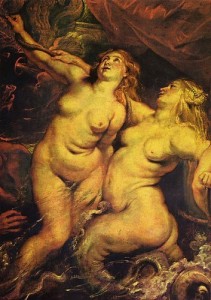
Peter Paul Rubens, The Landing of Maria de’ Medici at Marseille, 3 November, 1600 (detail), 1622-1625. Oil on canvas, 394 x 295 cm. Musée du Louvre, Paris.
I’m not sure whether or not it’s too late for western societies, young girls especially, to get over busting their butts (no pun intended) to be waif-thin. Luckily for women everywhere, the beauty aesthetic changes with the times, so perhaps the next desired woman of said times will be able to just be who she is – beautiful at any size, confident, and intelligent. Because, really, isn’t it confidence that makes a person sexy?
Relish in the curves, bottoms, and bosoms of yesteryear at the Peter Paul Rubens exhibit in the Von Der Heydt-Museum, Wuppertal from 10.16.2012-28.02.2013. Also for your viewing pleasure, procure these colourful ebooks: Peter Paul Rubens and Baroque Art. Finally, ladies, feel free to say YES to your next piece of cake or pie and love the skin you’re in.
-Le Lorrain Andrews
*All joking and sarcasm aside, please do not take my lightness towards exercise seriously. Walk, swim, run, join a yoga or salsa class; hop, skip, or jump. Whatever you do, keep moving.
During his time, Gustave Caillebotte was known as a great supporter of the Impressionist movement. He had quite a bit of money due to a hefty allowance and inheritance from his father, which allowed him to purchase the works of his fellow Impressionists, subsidise several exhibitions, and even pay the rent for Monet’s studio. It wasn’t until after his death that Caillebotte was finally recognised as one of the great masters of Impressionism rather than simply a piggy bank for his friends. I suppose it’s typical for artists not to receive recognition and acclaim during their time, but it’s too bad that Caillebotte’s groundbreaking style, a mix between Realism and Impressionism, was clouded by his role as the Sugar Daddy of Impressionism.
Although classified as an Impressionist, Caillebotte’s style clearly differs from his counterparts such as Degas, Monet, Renoir, and Pissarro with whom he displayed his works at the second Impressionist exhibition in 1876. Many—myself included–consider him more of a Realist than an Impressionist. Due to Caillebotte’s passion for photography, his paintings often resemble photographs, capturing a single, fleeting moment in time quite realistically.
Like his contemporaries, Caillebotte captured images of a rapidly changing Paris, the result of Napoleon III and Baron Georges-Eugene Haussmann’s urban renewal project. Beautiful, tree-lined boulevards, green spaces and gardens, and modern public facilities arose, paving the way for the beautiful, dreamy Paris we all know today. However, unlike his fellow Impressionists, Caillebotte attempted to depict the new Paris in a more realistic way; his paintings often create a feeling of alienation and sorrow (Paris Street, Rainy Day, above). For him, the new metropolitan city, with its meticulously planned layout and design, was something like a SimCity—perfect from the outside, lonely from the inside.
Caillebotte is also known for introducing a new subject matter: the urban working class. As a result of the new railway and the Industrial Revolution in France (1815-1860), there was a huge migration of workers from the countryside to Paris. This new social class, la class ouvrière or the working class, became a fascination of Caillebotte’s. However, up to this point, the only portrayals of working-class life had been of peasants and farmers from the countryside. Hence, it came as no surprise that the Salon rejected The Floor Scrapers (above) in 1875, deeming it vulgar and offensive. They simply did not want to accept the reality—the sorrow, the poverty, and the brutal working conditions—of their new and improved Paris that Caillebotte so desperately wanted to portray through his work.
Want to see Caillebotte’s works and some outstanding photography from the late 19th and early 20th centuries? Head over to Schirn Kunsthalle Frankfurt between 18 October 2012 and 20 January 2013 for their exhibit Gustave Caillebotte. An Impressionist and Photography. You can also check out our ebook on Impressionism by Nathalia Brodskaya to learn more.
Ukrainian-born Ilya Repin’s life spanned the turn of the 20th century, a particularly turbulent period in Russian history. A member of the Itinerants, he is one of the most celebrated social realist painters of all time, painting the lives of poor peasants and revolutionaries in exquisite detail, eschewing the burgeoning contemporary European impressionist movement. His paintings are a satirical commentary on the contemporary society of the Russian Empire, depicting scenes of peasantry (‘Barge Haulers on the Volga’), political and military scenes (‘Demonstration 17 October 1905’) and Cossack life (‘The Reply of the Zaporozhian Cossacks to Sultan Mahmoud IV’).
Soon after his death in 1930, Repin had developed into a cult figure. Revered by Stalin (supposedly his “favourite artist”*), his realistic portrayals of daily life inspired the ‘Socialist Realism’ of the new, centralised USSR. This genre depicted the suffering working classes as heroic in their struggles, which became heightened as the “elite” of the Stalinist regime were hypocritically bathing in the excesses that the position afforded them.
Stalin and Repin had similar beginnings, in that they were born into poorer families, in non-Russian soviet republics; the former being a Bolshevik revolutionary, whilst the latter was undoubtedly a sympathiser in the fight for social justice. However, somewhere along the way Stalin’s desire to escape the misery of his childhood lead to an abandonment of his roots, a skewing of his principles and a misappropriation of Repin’s work to champion his newly-held ideals.

Ilya Repin, Leo Tolstoy as a Ploughman on a Field, 1887. Oil on cardboard, 27.8 x 40.3 cm. The State Tretyakov Gallery, Moscow
Why is it that there is so often a discrepancy between the austere measures a regime advocates for its citizens and the lavish lifestyle the officials themselves lead? From examples as tame as the privately educated millionaires that make up the current British government, and the ostentation of the Pope, to the more extreme cases of autocrats living the high-life whilst their citizens starve, this is evident the world over and repeated cyclically.
As power turns heads, it also turns minds. A love of art may become more sterile, as only ‘state-approved’ art get the seal of approval. Hitler approved of the Great Masters, where the spiritual morality and family values depicted could be manipulated to suit his own manifesto, as well as having art made to order by his favourite, compliant artists. Under most dictatorships, artistic intelligentsia are driven underground for fear of being purged, either for vocally dissenting from the regime, or due to the expectation that they would do so.
Ironically, if Repin had been alive during Stalin’s reign of terror, it is reasonable to believe that he would have been painting scenes to satirise this monstrous hypocrite and his actions that, amongst other things, lead to around 7 million of Repin’s compatriots starving to death during the Ukrainian Famine of 1933. And had he lived on to lampoon, he would almost certainly no longer have been Stalin’s golden boy.
IF YOU HAPPEN TO BE IN TOKYO, CHECK OUT THE BUNKAMURA MUSEUM WHERE THEY ARE HOLDING AN EXHIBITION (‘ILYA REPIN: MASTER WORKS FROM THE STATE TRETYAKOV GALLERY’, UNTIL MONDAY 8 OCTOBER) FEATURING 80 REPIN WORKS ON LOAN FROM THE STATE TRETYAKOV GALLERY. IF JAPAN SEEMS LIKE A LONG WAY TO GO TO SEE REPIN’S WORKS, WHY NOT TRY THIS ILYA REPIN EBOOK INSTEAD, FEATURING MANY MORE MASTERPIECES BY THIS EXCELLENT REALIST PAINTER.
* RAPPEPORT, H. (1999). ART AND ARCHITECTURE. IN: JOSEPH STALIN: A BIOGRAPHICAL COMPANION. (P. 7). CALIFORNIA: ABC-CLIO, INC.
By Category
Recent News
- 04/03/2018 - Alles, was du dir vorstellen kannst, ist real
- 04/03/2018 - Tout ce qui peut être imaginé est réel
- 04/03/2018 - Everything you can imagine is real
- 04/02/2018 - Als deutsche Soldaten in mein Atelier kamen und mir meine Bilder von Guernica ansahen, fragten sie: ‘Hast du das gemacht?’. Und ich würde sagen: ‘Nein, hast du’.
- 04/02/2018 - Quand les soldats allemands venaient dans mon studio et regardaient mes photos de Guernica, ils me demandaient: ‘As-tu fait ça?’. Et je dirais: “Non, vous l’avez fait.”


